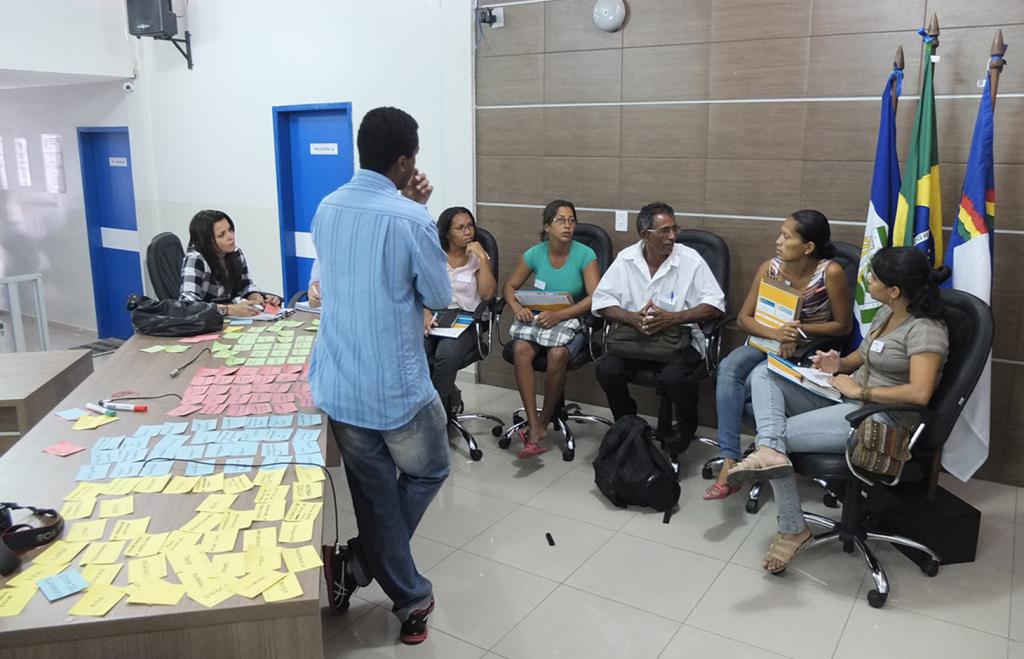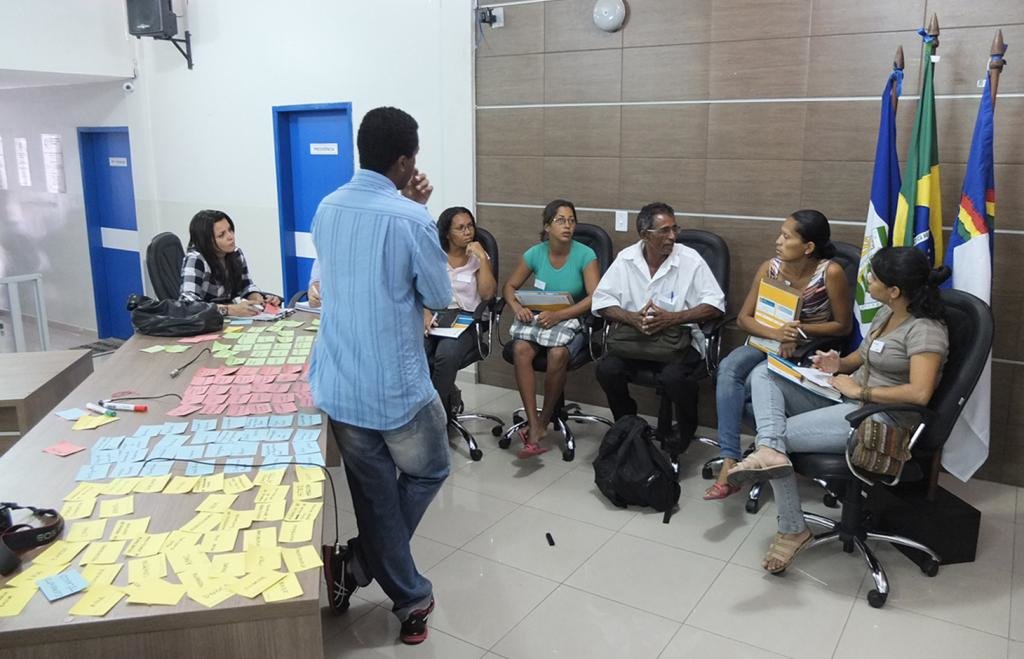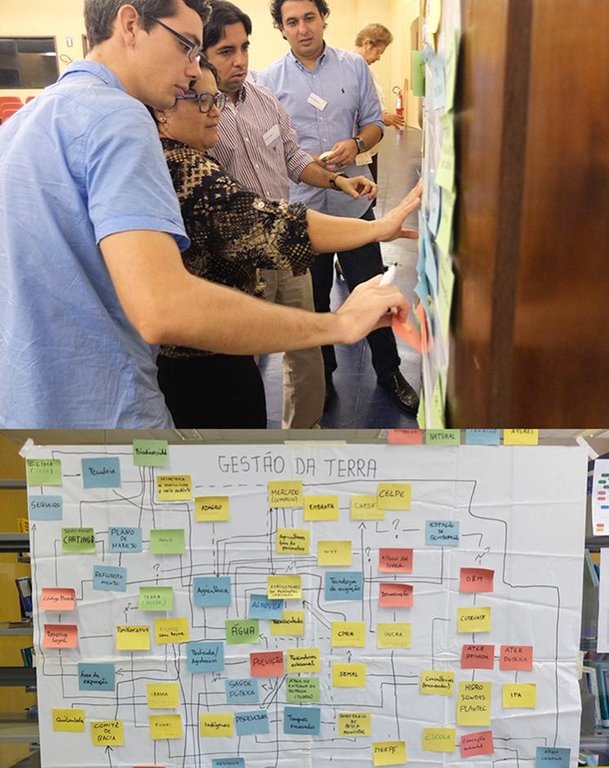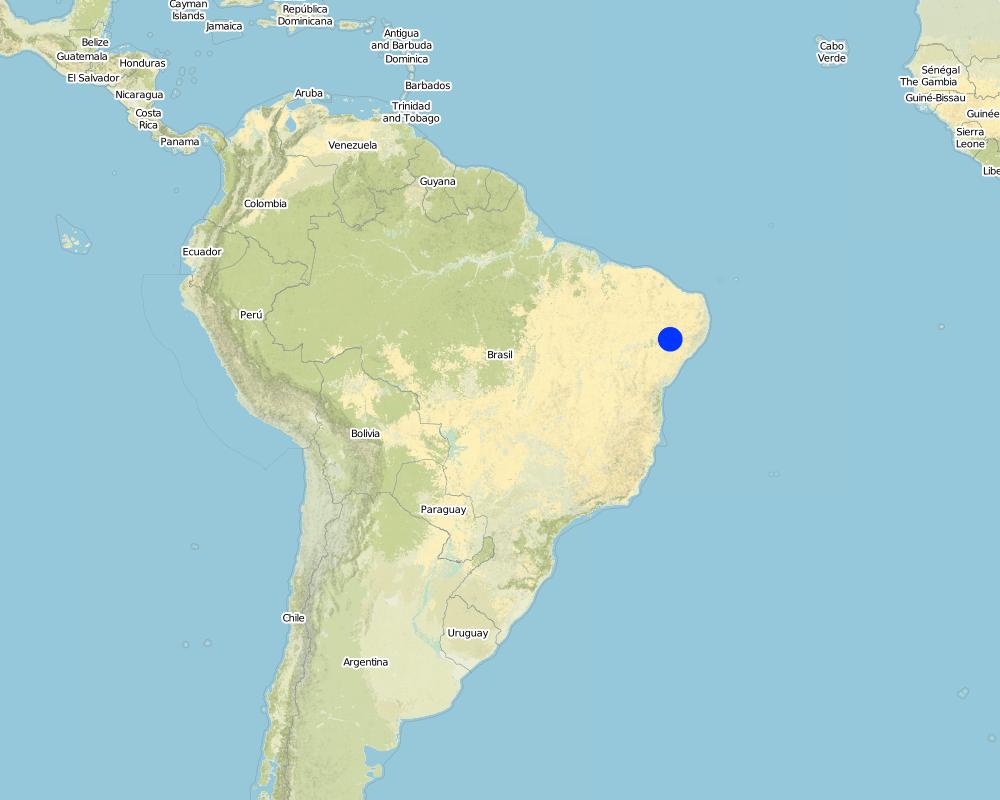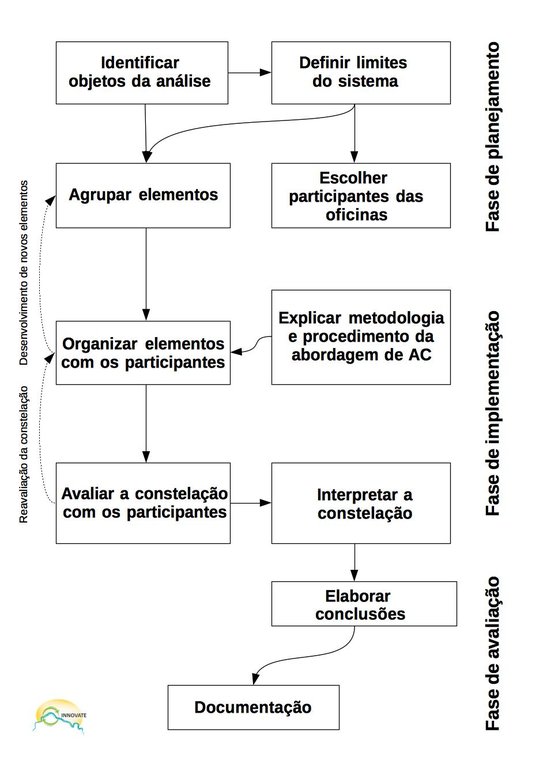Constellation Analysis [ບາຊິວ]
- ການສ້າງ:
- ປັບປູງ:
- ຜູ້ສັງລວມຂໍ້ມູນ: Verena Rodorff
- ບັນນາທິການ: –
- ຜູ້ທົບທວນຄືນ: Deborah Niggli
Análise de Constelação
approaches_1974 - ບາຊິວ
ເບິ່ງພາກສ່ວນ
ຂະຫຍາຍທັງໝົດ ຍຸບທັງໝົດ1. ຂໍ້ມູນທົ່ວໄປ
1.2 ລາຍລະອຽດ ການຕິດຕໍ່ ຂອງບຸກຄົນທີ່ຊັບພະຍາກອນ ແລະ ສະຖາບັນ ການມີສ່ວນຮ່ວມ ໃນການປະເມີນຜົນ ແລະ ເອກະສານ ຂອງວິທີທາງ
ຜູ້ຊ່ຽວຊານ ດ້ານການຄຸ້ມຄອງ ທີ່ດິນແບບຍືນຍົງ:
ຊື່ຂອງໂຄງການ ທີ່ອໍານວຍຄວາມສະດວກ ໃນການສ້າງເອກກະສານ ຫຼື ປະເມີນດ້ານແນວທາງ (ຖ້າກ່ຽວຂ້ອງ)
Book project: Making sense of research for sustainable land management (GLUES)1.3 ເງື່ອນໄຂ ຂອງການນໍາໃຊ້ເອກກະສານຂໍ້ມູນ ຂອງ WOCAT
ເມື່ອໃດທີ່ໄດ້ສັງລວມຂໍ້ມູນ (ຢູ່ພາກສະໜາມ)?
23/06/2015
ຜູ້ສັງລວມ ແລະ ບັນດາຜູ້ຕອບແບບສອບຖາມ ຍອມຮັບໃນເງື່ອນໄຂ ການນໍາໃຊ້ຂໍ້ມູນເອກະສານ ທີ່ສ້າງຂື້ນ ໂດຍຜ່ານ ອົງການ WOCAT:
ແມ່ນ
2. ພັນລະນາ ແນວທາງການຄຸ້ມຄອງນໍາໃຊ້ດິນແບບຍືນຍົງ
2.1 ການອະທິບາຍ ໂດຍຫຍໍ້ ຂອງວິທີທາງ
Constellation Analysis is a tool used to clarify perceptions of different stakeholders about critical situations or problems. In workshops, participants visualize interrelationships between actors, as well as the associated natural, technical and regulatory factors.
2.2 ການອະທິບາຍ ລາຍລະອຽດ ຂອງວິທີທາງ
ການອະທິບາຍ ລາຍລະອຽດ ຂອງວິທີທາງ:
The Constellation Analysis method (CA) aims at a transparent, mutually accepted visualization of factors (‘elements’) that are systematically arranged under the method's four categories: actors; rules and concepts; natural elements; technical elements, with the type of their inter-relationships. The process enables consensus to be found between divergent positions, paving the way for better informed decision-making while facilitating a negotiated process of land management with potential changes/techniques.
During brainstorming and/or literature-based approach, different elements are determined and arranged visually on a board. Element categories are actors (e.g. farmers, energy supply company), rules and concepts (e.g. legal framework, plans and programs, regulations), natural factors (e.g. climate, vegetation, water) and technical factors (e.g. fertilizer, wastewater treatment, hydropower plant). Usually this is done by using differently coloured and shaped cards to help articulate ideas within a working group. Then, connections among and between the elements are discussed and the form of these interrelations are visualized as being (a) directed, (b) conflictive, (c) non-existent, (d) contradictory, (e) reluctant or (f) interactive. Through this approach the way towards developing solutions (or follow-up CAs) is guided.
The approach was applied at different scales and with different stakeholders with divergent professional expertise and educational levels, e.g. farmers, fishermen, employees of the government, representatives of indigenous tribes, associations, trade unions, and researchers. People found the methodology promising as it raises awareness and organizes information. Training in the methodology has been carried out amongst interested people at two universities, but not yet local development agents.
The visualization is carried out through an iterative group process. A moderator is needed to initiate the process by inviting the different stakeholders to a conducive location, and to facilitate the process. Exchange among participants is enhanced, and this leads to better understanding of different viewpoints in situations of tension or in the understanding of what has evolved through specific developments in the past. During a second analytical step, the main lessons of the visualization are extracted and documented. Here, missing factors/relationships, and consequently the need for action, are detected. For example, insufficient communication between actors could be uncovered, or it may be detected that planning programs need to be improved.
2.3 ຮູບພາບຂອງແນວທາງ
2.5 ປະເທດ / ເຂດ / ສະຖານທີ່ບ່ອນທີ່ແນວທາງໄດ້ຖືກນໍາໃຊ້
ປະເທດ:
ບາຊິວ
ພາກພື້ນ / ລັດ / ແຂວງ:
Pernambuco, Brazil
ຂໍ້ມູນເພີ່ມເຕີມຂອງສະຖານທີ່:
Itaparica Reservoir, Petrolândia
Map
×2.6 ວັນທີເລີ່ມຕົ້ນ ແລະ ສິ້ນສຸດ ການຈັດຕັ້ງປະຕີບັດ ວິທີທາງ
ສະແດງປີຂອງການເລີ່ມຕົ້ນ:
2012
ປີທີ່ສີ້ນສູດ (ຖ້າຢຸດບໍ່ໄດ້ນໍາໃຊ້ ວິທີທາງ):
2016
2.7 ປະເພດຂອງແນວທາງ
- ພາຍໃຕ້ໂຄງການ / ແຜນງານ
2.8 ເປົ້າໝາຍ / ຈຸດປະສົງຫຼັກ ຂອງການຈັດຕັ້ງປະຕິບັດ ວິທີທາງ
The approach can be applied at different levels and for different issues or contexts: all perspectives can be represented and discussed. The application in this case was devised to be an iterative process of consecutive workshops first at the local irrigation project level, and then at the municipal, regional and national levels with the aim of analysing the inhibiting and driving forces behind the current situation in water management, in land management, and around production cycles in agriculture and aquaculture leading to action being taken or decisions made. Farmers and fishermen, employees of government, researchers and experts are considered as the relevant target group to be involved in participatory workshops. In the education sector, the approach can be applied for theses, for field work and for projects as an analytical interdisciplinary approach.
2.9 ເງື່ອນໄຂອໍານວຍ ຫຼື ຂັດຂວາງການປະຕິບັດຂອງເຕັກໂນໂລຢີ / ເຕັກໂນໂລຢີການນໍາໃຊ້ຕາມແນວທາງ
ສັງຄົມ / ວັດທະນະທໍາ / ມາດຕະຖານ ແລະ ຄຸນຄ່າທາງສາສະໜາ
- ອໍານວຍ
In some cases, segregation of social or gender groups, especially at the beginning of the exercise, can be helpful. No means has yet been found to reduce ‘mobile phone distraction’ in an acceptable way.
ການກໍ່ຕັ້ງສະຖາບັນ
- ອໍານວຍ
Argumentation promoting the value of the process may help to ‘sell’ the approach.
ຄວາມຮູ້ກ່ຽວກັບການຄຸ້ມຄອງ ທີ່ດິນແບບຍືນຍົງ, ການເຂົ້າເຖິງການສະໜັບສະໜູນ ທາງດ້ານວິຊາການ
- ອໍານວຍ
It may be possible to organize a pick-up service for participants or to choose an easy-access location.
ວຽກ, ມີກໍາລັງຄົນ
- ອໍານວຍ
It is important to discuss potential dates in advance. Some people prefer weekends, others don’t. The lunch break is useful for more informal interaction. However others use the break to disappear.
ອື່ນໆ
- ອໍານວຍ
The iterative process of the CA promotes a re-assessment of constellations during different group discussions. Views of dominant individuals can be modified in the iterative procedure, especially when participants with different standpoints and positions are involved. The goal is the mutual understanding of divergent positions towards entry points for change or adaptation.
3. ການມີສ່ວນຮ່ວມ ແລະ ບົດບາດຂອງພາກສ່ວນທີ່ກ່ຽວຂ້ອງທີ່ໄດ້ມີສ່ວນຮ່ວມ
3.1 ຜູ້ມີສ່ວນຮ່ວມ ໃນວິທີທາງ ແລະ ພາລະບົດບາດ ຂອງເຂົາເຈົ້າ
- ຜູ້ນໍາໃຊ້ດິນໃນທ້ອງຖິ່ນ / ຊຸມຊົນທ້ອງຖິ່ນ
smallholders of local agricultural community
- ຜູ້ຊ່ຽວຊານ ການນຄຸ້ມຄອງ ທີ່ດິນແບບຍືນຍົງ / ທີ່ປຶກສາດ້ານກະສິກໍາ
- ຄູອາຈານ / ນັກຮຽນ / ນັກສຶກສາ
students only in observing role
- ພະນັກງານຂັ້ນສູນກາງ (ຜູ້ວາງແຜນ, ຜູ້ສ້າງນະໂຍບາຍ)
3.2 ການມີສ່ວນຮ່ວມຂອງຜູ້ນໍາໃຊ້ທີ່ດິນໃນທ້ອງຖິ່ນ / ຊຸມຊົນທ້ອງຖິ່ນໃນໄລຍະທີ່ແຕກຕ່າງກັນຂອງແນວທາງ
| ການລວບລວມ ເອົາຜູ້ນໍາໃຊ້ດິນ ໃນທ້ອງຖິ່ນ / ຊຸມຊົນທ້ອງຖິ່ນ | ໃຫ້ລະບຸ ຜູ້ໃດທີ່ມີສ່ວນຮ່ວມ ໃນແຕ່ລະກິດຈະກໍາ? | |
|---|---|---|
| ການເລີ່ມຕົ້ນ / ແຮງຈູງໃຈ | ການບໍ່ປະຕິບັດ | Interviews |
| ການວາງແຜນ | ບໍ່ມີ | |
| ການປະຕິບັດ | ການຮ່ວມມື | Workshops |
| ຕິດຕາມກວດກາ / ການປະເມີນຜົນ | ການຮ່ວມມື | Workshops |
| research | ການຮ່ວມມື | Data analysis, lessons learnt, etc |
3.3 ແຜນວາດ (ຖ້າມີ)
ການອະທິບາຍ:
Simplified flowchart of the Constellation Analysis Approach.
Planning phase:
Clarify the objective or question behind the analysis. Then, have an overview research about first elements (assembling elements), e.g. which actors can give interesting input and how to contact them. Preparing material for the workshop(s): coloured cards, pens, whiteboard, etc.
Implementation phase:
Explain the objective and methodology to participants, the meaning of the elements: actors; rules and concepts; natural elements; technical elements and their different relations. Clarify rules of respecting each other. Arrange the elements. Evaluate the constellation together with participants, e.g. why are elements far or close to each other? Why are relations conflictive and how to overcome? Are elements or relations missing? Is all information available? What are the next step? Can recommendations be formulated?
Evaluation phase:
Were participants objective enough? How to interpret participant’s activity within the workshop? Which actors should be asked as well? Consolidate participants’ statements with literature and research and document. Documentation could be a photo or digitalized picture of results with an explanation based on literature.
ຜູ້ຂຽນ:
Liron Steinmetz
3.4 ການຕັດສິນໃຈກ່ຽວກັບການຄັດເລືອກເຕັກໂນໂລຢີຂອງການຄຸ້ມຄອງທີ່ດິນແບບຍືນຍົງ / ເຕັກໂນໂລຢີ
ລະບຸ ຄົນທີ່ຕັດສິນໃຈ ກ່ຽວກັບການຄັດເລືອກຂອງ ເຕັກໂນໂລຢີ / ເຕັກໂນໂລຢີ ຈະໄດ້ຮັບການປະຕິບັດ:
- ຜູ້ນໍາໃຊ້ທີ່ດິນຫຼັກ, ການສະໜັບສະໜູນ ໂດຍຜູ້ຊ່ຽວຊານ ການນໍາໃຊ້ທີ່ດິນແບບຍືນຍົງ
ອະທິບາຍ:
Constellation Approach is not linked with a specific technology. Can be used in a planning phase in sustainable land management. Various methods, technologies and management approaches can be derived from the applied Constellation CA Approach, and can be specified depending on the SLM problem.
4. ການສະໜັບສະໜູນທາງດ້ານວິຊາການ, ການສ້າງຄວາມສາມາດ, ແລະ ການຈັດການຄວາມຮູ້.
4.1 ການສ້າງຄວາມສາມາດ / ການຝຶກອົບຮົມ
ຜູ້ນໍາໃຊ້ທີ່ດິນ ຫຼື ພາກສ່ວນກ່ຽວຂ້ອງອື່ນໆ ໄດ້ຮັບການຝຶກອົບຮົມບໍ່?
ແມ່ນ
ໃຫ້ລະບຸ ຜູ້ໃດທີ່ໄດ້ຮັບການຝຶກອົບຮົມ:
- ຜູ້ນໍາໃຊ້ດິນ
- ພະນັກງານພາກສະໜາມ / ທີ່ປຶກສາ
ຮູບແບບຂອງການຝຶກອົບຮົມ:
- workshops
ໃນຫົວຂໍ້:
detecting knowledge gaps and clarifying positions of players, and role of natural, technical and regulatory elements from multi-angled viewpoints/perspectives as core of the CA-Approach.
4.2 ການບໍລິການໃຫ້ຄໍາປຶກສາ
ເຮັດຜູ້ໃຊ້ທີ່ດິນມີການເຂົ້າເຖິງການບໍລິການໃຫ້ຄໍາປຶກສາ?
ແມ່ນ
- workshops
4.3 ສະຖາບັນການສ້າງຄວາມເຂັ້ມແຂງ (ການພັດທະນາອົງການຈັດຕັ້ງ)
ສະຖາບັນ ໄດ້ຮັບການສ້າງຕັ້ງຂື້ນ ຫຼື ໄດ້ຮັບການສ້າງຄວາມເຂັ້ມແຂງ ໂດຍການຈັດຕັ້ງປະຕິບັດ ວິທີທາງບໍ່?
- ບໍ່ມີ
4.4 ຕິດຕາມກວດກາ ແລະ ປະເມີນຜົນ
ການຈັດຕັ້ງປະຕິບັດ ວິທີທາງ ໄດ້ມີການປະເມີນຜົນ ແລະ ຕິດຕາມບໍ?
ແມ່ນ
ຖ້າແມ່ນ, ເອກກະສານສະບັບນີ້ ແມ່ນໄດ້ນໍາໃຊ້ເຂົ້າໃນການຕິດຕາມ ແລະ ປະເມີນຜົນບໍ່?
ບໍ່ແມ່ນ
4.5 ການຄົ້ນຄວ້າ
ນີ້້ແມ່ນສ່ວນໜຶ່ງ ການຄົ້ນຄວ້າ ຂອງວິທີທາງບໍ່?
ແມ່ນ
ລະບຸ ຫົວຂໍ້:
- ສັງຄົມ
- ເສດຖະສາດ / ການຕະຫຼາດ
- ລະບົບນິເວດ
- ເຕັກໂນໂລຢີ
5. ການສະໜັບສະໜູນທາງດ້ານການເງິນ ແລະ ອຸປະກອນຈາກພາຍນອກ
5.1 ງົບປະມານປະຈໍາປີ ສໍາລັບວິທີທາງ ຂອງການຄຸ້ມຄອງ ທີ່ດິນແບບຍືນຍົງ
ຖ້າຫາກບໍ່ຮູ້ຈັດງົບປະມານທີ່ແນ່ນອນ ແມ່ນໃຫ້ປະມານເອົາ:
- < 2,000
ຄໍາເຫັນ (ຕົວຢ່າງ: ແຫຼ່ງຂໍ້ມູນຫຼັກ ຂອງການສະໜອງທຶນ / ຜູ້ໃຫ້ທຶນທີ່ສໍາຄັນ):
German Federal Ministry of Education and Research (BMBF) 100%
5.2 ການສະໜັບສະໜູນ ທາງດ້ານການເງິນ / ອຸປະກອນ ສະໜອງໃຫ້ແກ່ຜູ້ນໍາທີ່ດິນ
ຜູ້ນໍາໃຊ້ດິນ ໄດ້ຮັບການສະໜັບສະໜູນ ທາງດ້ານ ການເງິນ / ອຸປະກອນ ໃນການຈັດຕັ້ງປະຕິບັດ ເຕັກໂນໂລຢີບໍ?
ບໍ່ແມ່ນ
5.3 ເງິນສົມທົບສໍາລັບການນໍາໃຊ້ສະເພາະປັດໃຈຂາເຂົ້າໃນການຜະລີດກະສິກໍາ (ລວມທັງແຮງງານ)
- ບໍ່ມີ
ຖ້າແຮງງານ ຂອງຜູ້ນໍາໃຊ້ດິນ ໄດ້ຮັບການສະໜັບສະໜູນ ປັດໃຈຂາເຂົ້າ, ແມ່ນບໍ່:
- ການອາສາ
5.4 ສິນເຊື່ອ
ໄດ້ປ່ອຍສິນເຊື່ອ ສະໜອງໃຫ້ພາຍໃຕ້ ວິທີການສໍາລັບກິດຈະກໍາ ການຄຸ້ມຄອງ ທີ່ດິນແບບຍືນນຍົງບໍ່?
ບໍ່ແມ່ນ
5.5 ສິ່ງຈູງໃຈ ຫຼື ເຄື່ອງມືອື່ນໆ
ການສົ່ງເສີມ ຈັດຕັ້ງປະຕິບັດ ເຕັກໂນໂລຢີ ໃນການຄຸ້ມຄອງ ດິນແບບຍືນຍົງ ໄດ້ສະໜອງສິ່ງກະຕຸກຊຸກຍູ້ບໍ່?
ບໍ່ແມ່ນ
6. ວິເຄາະຜົນກະທົບ ແລະ ສັງລວມບັນຫາ
6.1 ຜົນກະທົບຂອງແນວທາງ
ການຈັດຕັ້ງປະຕິບັດ ວິທີທາງ ສາມາດຊ່ວຍຜູ້ນໍາໃຊ້ທີ່ດິນ ໃນການຈັດຕັ້ງປະຕິບັດ ແລະ ບໍາລຸງຮັກສາ ເຕັກໂນໂລຢີ ການຄຸ້ມຄອງ ທີ່ດິນແບບຍືນຍົງໄດ້ບໍ?
- ບໍ່
- ມີ, ໜ້ອຍໜຶ່ງ
- ມີ, ພໍສົມຄວນ
- ມີ, ຫຼາຍ
No immediate impact, however CA-Approach could prospectively contribute to improved sustainable land management and in particular governance.
ການຈັດຕັ້ງປະຕິບັດ ວິທີທາງ ສາມາດສ້າງຄວາມເຂັ້ມແຂງ ທາງສັງຄົມ ແລະ ເສດຖະກິດບໍ່?
- ບໍ່
- ມີ, ໜ້ອຍໜຶ່ງ
- ມີ, ພໍສົມຄວນ
- ມີ, ຫຼາຍ
No immediate impact, however CA-Approach could prospectively contribute to an improved situation of socially and economically disadvantaged groups.
Did other land users / projects adopt the Approach?
- ບໍ່
- ມີ, ໜ້ອຍໜຶ່ງ
- ມີ, ພໍສົມຄວນ
- ມີ, ຫຼາຍ
Interest from cooperating universities (UFPE-Universidade Federal de Pernambuco, IFPE-Instituto Federal de Pernambuco).
Did the Approach lead to improved livelihoods / human well-being?
- ບໍ່
- ມີ, ໜ້ອຍໜຶ່ງ
- ມີ, ພໍສົມຄວນ
- ມີ, ຫຼາຍ
No immediate impact, however CA-Approach could prospectively contribute to improved well-being.
6.2 ແຮງຈູງໃຈຫຼັກຂອງຜູ້ນໍາໃຊ້ທີ່ດິນໃນການປະຕິບັດການຄຸ້ມຄອງທີ່ດິນແບບຍືນຍົງ
- ການຜະລິດເພີ່ມຂຶ້ນ
- ກຽດສັກສີ, ຄວາມກົດດັນທາງສັງຄົມ / ການຕິດຕໍ່ກັນທາງສັງຄົມ
- ລວມເຂົ້ານໍາກັນກັບການເຄື່ອນໄຫວ / ໂຄງການ / ກຸ່ມ / ເຄືອຂ່າຍ
- ຄວາມຮັບຮູ້ ທາງສີ່ງແວດລ້ອມ
6.3 ຄວາມຍືນຍົງຂອງກິດຈະກໍາວິທີທາງ
ຜູ້ນໍາໃຊ້ ທີ່ດິນ ສາມາດສືບຕໍ່ ການຈັດຕັ້ງປະຕິບັດ ຜ່ານວິທີທາງໄດ້ບໍ່ (ໂດຍປາດສະຈາກ ການຊ່ວຍເຫຼືອ ຈາກພາກສ່ວນພາຍນອກ)?
- ແມ່ນ
ຖ້າ ໄດ້, ອະທິບາຍເຫດຜົນ:
Attained knowledge on a complex, perhaps previously nontransparent system and established contacts support future decision making. In general CA is a flexible method that can be applied by any group, preferentially mixed stakeholder groups.
6.4 ຈຸດແຂງ / ຂໍ້ດີ ຂອງວິທີທາງ
| ຈຸດແຂງ / ຂໍ້ດີ / ໂອກາດໃນການນໍາໃຊ້ທີ່ດິນ |
|---|
| Results can be used for the planning of regional development. |
| Space for interchange of ideas and establishing contacts. |
| Integrates different views of problems. |
| Facilitates participation possibilites for stakeholders. |
| ຈຸດແຂງ / ຈຸດດີ / ໂອກາດ ຈາກທັດສະນະຂອງຜູ້ປ້ອນຂໍ້ມູນ ຫຼື ບຸກຄົນສຳຄັນ |
|---|
| Allows expression and discussion of different views, knowledge integration, both inter- and transdisciplinary, characterised by an iterative and participative nature, able to detect complex situations and questions. |
6.5 ຈຸດອ່ອນ / ຂໍ້ເສຍຂອງແນວທາງ ແລະ ວິທີການແກ້ໄຂໃຫ້ເຂົາເຈົ້າ
| ຈຸດອ່ອນ / ຂໍ້ເສຍ / ຄວາມສ່ຽງໃນມູມມອງຂອງຜູ້ນໍາໃຊ້ທີ່ດິນ | ມີວິທີການແກ້ໄຂຄືແນວໃດ? |
|---|---|
| Insufficient space for all to participate, topics covered in too little time. As more than one workshop is needed, the approach does not necessarily provide solutions in the end. | Prepare goal-orientated workshops and finish a workshop by identifying potential solutions and formulating recommendations. I is important to well document and report on the workshops and distribute the reports to stakeholders. |
| ຈຸດອ່ອນ ຫຼື ຂໍ້ເສຍ ຫຼື ຄວາມສ່ຽງ ໃນມຸມມອງຂອງ ຜູ້ສັງລວມຂໍ້ມູນ ຫຼື ບັນດາຜູ້ຕອບແບບສອບຖາມ | ມີວິທີການແກ້ໄຂຄືແນວໃດ? |
|---|---|
| One workshop cannot manage to convey the dynamics of a situation. | Formulate recommendations for action and distribute a report to stakeholders. |
| CA only visualizes the current situation. Different future scenarios over a given timespan can be presented only in a series of single CA visualizations. | CA could lay the groundwork for scenario modelling approaches (e.g. Bayesian Networks). |
| One workshop cannot manage to convey the dynamics of a situation. | Formulate recommendations for action and distribute a report to stakeholders. |
7. ເອກກະສານອ້າງອີງ ແລະ ຂໍ້ມູນການເຊື່ອມໂຍງ
7.1 ວິທີການ / ແຫຼ່ງຂໍ້ມູນ
- ການໄປຢ້ຽມຢາມພາກສະໜາມ, ການສໍາຫຼວດພາກສະໜາມ
- ການສໍາພາດ ຜູ້ນໍາໃຊ້ທີ່ດິນ
7.2 ເອກະສານທົ່ວໄປທີ່ສາມາດໃຊ້ໄດ້
ຫົວຂໍ້, ຜູ້ຂຽນ, ປີ, ISBN:
): Rodorff V.et al. (2013a) Driving forces and barriers for a sustainable management of the Itaparica reservoir region - basic milestones towards a constellation analysis.
ມີຢູ່ໃສ?ມູນຄ່າເທົ່າໃດ?
Gunkel G. et al. (Eds.) (2013) Sustainable Management of Water and Land in Semiarid Areas. Editora Universitária UFPE, Recife, pp 2
ຫົວຂໍ້, ຜູ້ຂຽນ, ປີ, ISBN:
Rodorff, V., Siegmund-Schultze, M., Köppel, J., Gomes, E.T.A. (2015) Governança da bacia hidrográfica do rio São Francisco: Desafios de escala sob olhares inter e transdisciplinares.
ມີຢູ່ໃສ?ມູນຄ່າເທົ່າໃດ?
Revista Brasileira de Ciências Ambientais 36, 30-56.
ຂໍ້ມູນການເຊື່ອມຕໍ່ ແລະ ເນື້ອໃນ
ຂະຫຍາຍທັງໝົດ ຍຸບທັງໝົດການເຊື່ອມຕໍ່
ບໍ່ມີຂໍ້ມູນການເຊື່ອມຕໍ່
ເນື້ອໃນ
ບໍ່ມີເນື້ອໃນ


